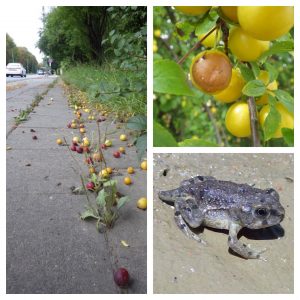2018 – 2021, NCN PRELUDIUM 14 (UMO-2017/27/N/NZ8/01996), Insects attracted by fallen fruits as a food source for amphibians.

In each annual cycle of a fruit tree comes the moment, when the fruits fall down. The next step of this process is decomposition during which a characteristic smell giving off attract numerous invertebrates. And what is the most interesting, this process may have great implication on functioning of the ecosystem. But how? Metamorphosis is a critical stage of amphibians life, during which they begin to feed intensively before the first hibernation. That is why, food availability influence physical growth during first month of terrestrial life. It has been shown that greater post-metamorphosis size of amphibians ensures greater survivability during hibernation.
Taking this into account it can be assumed that since fermenting fruits attract many types of invertebrates, the presence of fruit trees close to a breeding site might influence faster post-metamorphic growth of amphibians and their dispersion near breeding area. In order to analyse whether this assumption is true, three kinds of research will be carried out. The first one will combine information about the distribution of fruit trees and amphibian guilds in the suburban landscape and rural areas. This will help to explain the possible role of environmental patches with diverse species composition and the number of fruit trees. The next two research will be experimental studies. Juveniles of three amphibian species: common spadefoot, green and common toad will be kept in one out of three types of cages: 1) enclosure with fleshy fruits, 2) enclosure with synthetical fruit models and 3) enclosure without fleshy fruits. During these two experiments (which will last for 30 days) body mass and body length of each juvenile will be measured. This will help to explain whether presence of fallen fruits effect the faster growth due to presence of more varied food such as invertebrates or by the presence of additional hiding places that increase the efficiency of foraging.
Anthropogenic pressures and the deteriorating of environment directly influence extinction of amphibian populations. In terms of this fact, it is necessary to analyze changes in the environment and to study their impact on amphibians. That is why, carrying out the presented above research is important due to several reasons. First of all, if the study confirm the assumption, it mean that plum trees are important part of landscape also due to positive influence on amphibians. And this will be particularly important due to political and social pressure because fruit trees are being currently reducing in many urban and rural areas. Farther destruction of habitats by removing fruit trees may have negative impact on amphibians by limitation the food availability at an extremely crucial moment in life.
